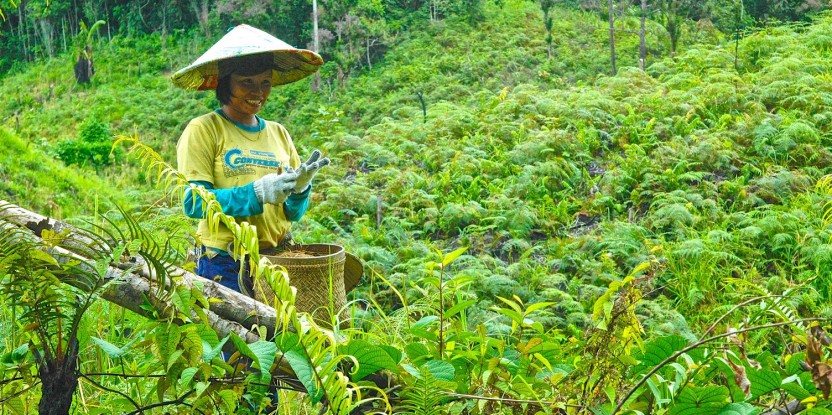
It’s long been stigmatized, blamed for destroying forests and releasing greenhouse gases.
But, when done properly, shifting cultivation can create natural ecosystems with high biodiversity, rich carbon stocks and low soil erosion.
The catch? It needs to be practiced over a large area to allow different plots of land to go through the cycle from crop to fallow, to young forest, to secondary forest. And it takes time.
This is what researchers discovered in a recent study that compared the level of biodiversity and ecosystem services in the traditional forest–swidden agriculture system of Northern Borneo with other land uses, such as natural forest and monoculture plantations.
FOREST TRANSITION
Borneo’s lowland tropical forests are hotspots for biodiversity and are rich in timber and carbon stocks. But they’re being replaced with oil palm and rubber plantations at an alarming rate, causing soil erosion, loss of species and higher greenhouse gas emissions.
Less is known about how land clearing through traditional shifting cultivation systems affects the environment.
“We found that all land-use types related to the forest-swidden system outperformed oil palm and rubber monocultures,” said Yves Laumonier, a Center for International Forestry Research (CIFOR) scientist and one of the study’s authors.
“Tree species diversity is greater, erosion is lower and above-ground carbon stocks are more than twice as high in swidden systems compared with plantations,” he added.
They carried out the fieldwork near Keluin village, Batang Lupar, West Kalimantan in northern Borneo, an agricultural landscape shaped by swidden farming, rubber tapping and logging. There, Laumonier and his colleagues identified a mosaic of seven different land-use types, including natural forest, logged-over forest, crop fields, several stages of secondary-growth forests and rubber gardens.
Not only do these different land-use types provide a diverse range of products, they complement each other in terms of ecosystem services and biodiversity
Not surprisingly, the researchers found that natural forests are host to a high diversity of unique tree species, have the lowest rate of soil erosion and store more carbon than any other type of land use.
Logged-over forests, where old growth and secondary tree species are often mixed in the same plot, also had high tree species diversity. But above-ground carbon stocks are low, and the remaining logging roads contribute to ongoing soil erosion.
In contrast, old secondary-growth forests and rubber gardens had higher carbon stocks and better erosion control than logged-over lands, but fewer tree species.
Looking at the big picture, the researchers point out that a balance can be struck at the landscape level.
While the authors make the case for protecting natural forests through financial mechanisms such as Reducing Emissions from Deforestation and Forest Degradation (REDD+), they also point to the inherent value of a mosaic landscape.
“Not only do these different land-use types provide a diverse range of products,” Laumonier said, “they complement each other in terms of ecosystem services and biodiversity.”
“In this way, the range of human activities, including agriculture, logging and rubber tapping – and, most importantly, leaving plots of cleared land to return to forest – ensures the continuous delivery of a variety of services,” he added.
This diversity of land uses also serves as a safety net when market prices of rubber, palm oil and timber suddenly fluctuate, creating resilience in local economies.
SHIFTING GENERATION
Laumonier and co-authors found the recovery time for soil and vegetation was longer in their study area than in similar studies elsewhere – a potential sign of degradation.
“We noticed large areas of degraded land around the village,” said Laumonier. “Overpopulation isn’t a factor here, so there must be another reason the plots weren’t being left to regenerate, which is the normal practice in shifting cultivation.”
Turns out age was a big factor.
The young men are migrating out the village to find work in Malaysia, leaving behind parents, aunts and uncles to tend to the crops. Unable to make the trek to clear traditional plots farther out, the older villagers end up working nearby fields far longer than usual.
To fully understand the role of swidden systems in the region, the authors note, more research is needed to understand the sociocultural and economic factors that are driving the faster rotation cycles, such as the ageing population.
We are not against oil palm. We just want to show where to plant oil palm and where absolutely not to do so
At the same time, Laumonier said there was strong pressure from local government and large companies to open up more land for oil palm plantations, in particular.
“We are not against oil palm,” he said. “We just want to show where to plant oil palm and where absolutely not to do so.”
A big part of that was valuing the cost of environmental degradation.
“Let’s say if you convert all of this forest to oil palm you get so many million dollars. But it will cost the community in terms of water quality,” he said. “So it’s quite important for us to provide numbers that help clarify the economics of the environment versus agricultural production.”
The authors hope this research will help raise awareness among decision-makers and land-use planners that logged-over forests are worth more than being converted to other land uses, and should be sustainably managed as part of the traditional swidden system.
We want you to share Forests News content, which is licensed under Creative Commons Attribution-NonCommercial-ShareAlike 4.0 International (CC BY-NC-SA 4.0). This means you are free to redistribute our material for non-commercial purposes. All we ask is that you give Forests News appropriate credit and link to the original Forests News content, indicate if changes were made, and distribute your contributions under the same Creative Commons license. You must notify Forests News if you repost, reprint or reuse our materials by contacting forestsnews@cifor-icraf.org.
